Japan
Wood Products Prices
Dollar Exchange Rates of 25th
Apr
2025
Japan Yen 144.22
Reports From Japan
Preliminary Japan/US
trade deal could soon be signed
The tariffs proposed by the US have raised concerns for
Japan's export-reliant economy especially as the US
proposes high import duties on cars, steel and aluminum.
A baseline 10% levy remains in place despite a 90-day
reprieve for "reciprocal" tariffs. The US is determined to
reduce the trade deficit with Japan and has targeted cars
and agricultural products.
Economic Revitalisation Minister, Akazawa Ryosei, was
appointed Minister in charge of trade talks. In the last
week of April Japan added 10 new members to its task
force for tariff negotiations drawing people from the
transport, agricultural and other ministries.
According to press reports in the US, a preliminary trade
deal could soon be signed with Japan although this could
be more like an outline for further negotiation rather than a
finalised agreement. The media report the two sides
remain far apart on some issues and it could take time for
an agreement.
Prime Minister Ishiba said that Japan has emphasised the
importance of free trade in bilateral tariff negotiations with
the United States while also highlighting Japanese
company investments in the United States.
There was serious concern that the US may demand action
to strengthen the yen but the US Treasury Secretary is
reported as saying the US has no currency targets in mind
when negotiating with Japan. However, he indirectly
discouraged Japan from foreign exchange interventions to
weaken the currency.
The yen remains low, an advantage for exporters, but the
currency has appreciated for three consecutive weeks
against the dollar as the uncertainty surrounding the global
trade war bolsters safe haven assets.
See: https://asia.nikkei.com/Economy/Trade-war/Trump-
tariffs/Bessent-US-will-not-pursue-currency-target-in-Japan-
trade-talks
and
https://www.japantimes.co.jp/business/2025/04/21/japan-
bullish-against-dollar/
and
https://mainichi.jp/english/articles/20250423/p2g/00m/0na
/044000c
Government considering measures to boost domestic
spending
Japan is urgently discussing economic stimulus measures
to address the potential fallout from US tariffs. The
government is considering measures to boost domestic
spending and shore up corporate balance sheets. Five areas
of focus were outlined in the emergency stimulus package:
strengthening the consultation framework for affected
businesses, assisting companies with their cash flows,
ensuring employment retention, stimulating consumption
and enhancing industrial competitiveness.
In a ministerial meeting on tariff responses Prime Minister
Shigeru Ishiba instructed ministers to get ahead of
potential problems and ensure effective implementation of
the policies.
See:
https://www.japantimes.co.jp/business/2025/04/25/economy/tarif
f-stimulus-
upped/?utm_source=pianodnu&utm_medium=email&utm_camp
aign=72&tpcc=dnu&pnespid=6.dikpue6paw.6iz9qajtoug5hwor3
nthbush0qhuxkv9s6zyx.qsgsh0p3jhjwbjb.w5q
Opposition party wants consumption tax on food
suspended
The largest opposition party in Japan announced it wants
the consumption tax rate on food items to be scrapped for
a year. This comes ahead of a crucial parliamentary
election this summer.
The country is bracing for the prospect of persistant
inflation and a hit from higher US tariffs driving debate on
how best to help households with the surging inflation.
Prime Minister Shigeru Ishiba, however, has so far ruled
out changing the consumption tax rate.
"People today are struggling. We need to face reality,"
Constitutional Democratic Party of Japan chief Yoshihiko
Noda said at a press conference. "We should be prepared
for what the Prime Minister has described as a 'national
crisis,' said Noda. Japan's consumption tax was raised
from 8 percent in 2019, but the rate on food and drinks is
still 8 percent.
See: https://www.asahi.com/ajw/articles/15726120
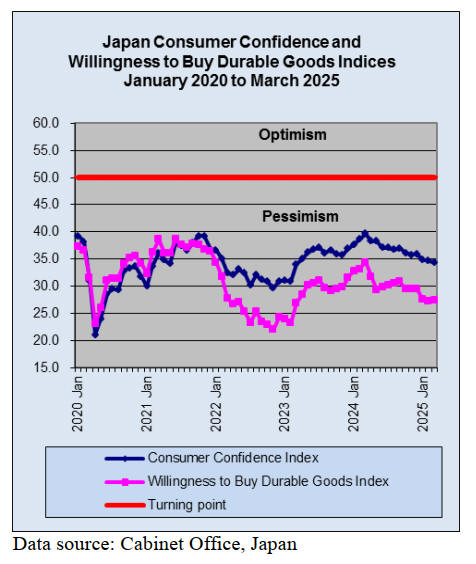
Buying yen as a safe alternative
US policy announcements have caused investors to sell
US dollars and buy yen as a safer alternative. This
strengthened the yen to 140 to the dollar briefly at the end
of April.
The US has claimed that Japan's currency is undervalued
with some in the US administration calling for a Plaza
Accord 2.0, a reference to the 1985 Plaza Accord, an
agreement between the US and a number of other
countries that led to a dramatic strengthening of the yen.
Japan insists that the value of the currency should be
decided by the markets and that governments should not
interfere.
Japan-US tariff talks avoide currency issues
After rising to its strongest level in months the yen
weakened against the US dollar in the second half of April
after Japan-US tariff talks avoided currency issues but
traders remain on guard for pressure from Washington.
The Japanese currency appreciated to 140 yen against the
dollar but retreated when Ryosei Akazawa, Japan's
Minister for Economic and Fiscal Policy, said
afterward that currencies had not been discussed.
After lifting borrowing costs three times since March of
last year the BoJ now faces unprecedented US tariff
measures which pose a threat to Japan’s economy.
See:
https://www.japantimes.co.jp/business/2025/04/28/economy/boj-
to-pause-on-rate-hike/
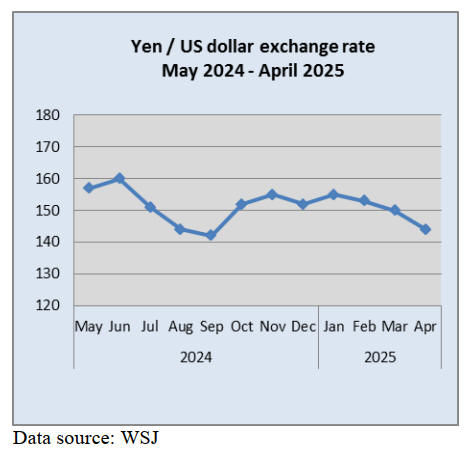
Average price of a new condominium at four year high
The average price of a new condominium exceeded yen
100 million (US$709,000) for the second straight year in
fiscal 2024 according to the Real Estate Economic
Institute. That was up 11% from the previous year hitting a
record high for the fourth consecutive year The continual
increases were put down to increases in land prices,
construction materials and labour expenses.
Tadashi Matsuda, a Senior Researcher, warned that
concerns about possible economic stagnation in light of
US tariff policy could affect consumer sentiment. The
average unit price of new condos in Kanagawa, Saitama
and Chiba grew 7.5%, also a record high.
See: https://www3.nhk.or.jp/nhkworld/en/news/20250421_20/
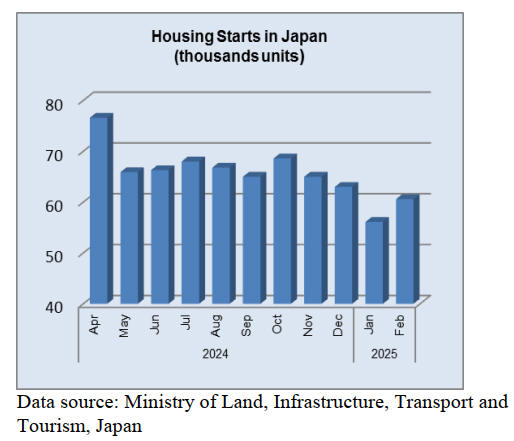
Likely pause in BoJ policy of ‘normalisation’
The Bank of Japan (BoJ) is widely expected to pause its
policy normalisation when it meets 1-2 May without
shifting its stance on gradually raising interest rates when
the outlook clears.
The BoJ is expected to keep the benchmark rate at 0.5%
according to all 54 economists surveyed. BoJ watchers
will scrutinise policymakers’ quarterly economic
projections for any hint on the extent of the pause.
Import update
Yen value of furniture imports
January saw the value of imports of each of the four
categories of wooden furniture tracked rise to year on year
highs but in February there was a major correction with
the value of all four categories falling.
In February the yen exchange rate against the US dollar
was around 150/US dollar suggesting the correction was
not the result of any appreciation of the yen which is now
being observed.
As could be expected there was a sharp reduction of
wooden furniture arrivals from China as factories there
close for the New Year celebrations. The decline in
arrivals from Vietnam was also influenced by factory
closures for the Tet holiday.
Because China and Vietnam account for a large part of
Japan’s wooden furniture imports the decline in their
shipments drove down overall import values.
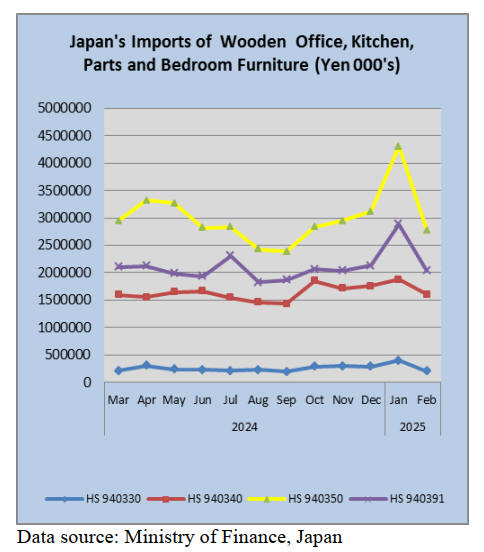
February wooden office furniture imports (HS 940330)
In February shippers in China accounted for 81% of
Japan’s imports of wooden office furniture (HS940330),
down from the 93% in January. The other main shippers in
February were Indonesia (5%) and the US (4%). Arrivals
of wooden office furniture from Malaysia in February
were down month on month.
Year on year, the value of Japan’s imports of wooden
office furniture in February down and compared to
January there was a sharp reduction.
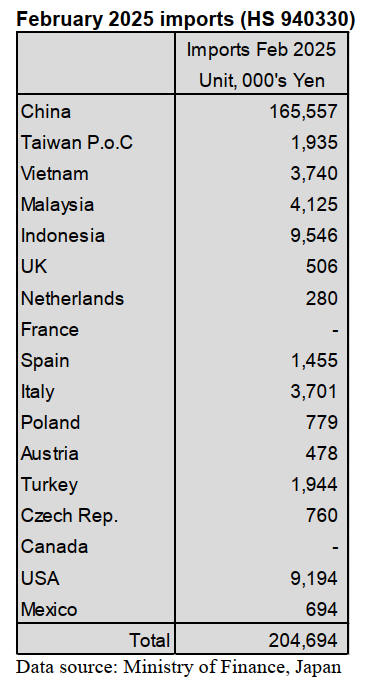
February wooden kitchen furniture imports (HS
940340)
The year on year value of Japan’s wooden kitchen
furniture imports was slightly higher in February but
compared to January the value of imports fell around 15%.
In February 2025 the combined value of shipments of
wooden kitchen furniture (HS940340) from the
Philippines and Vietnam accounted for over 77% of
Japan’s imports of HS940340.
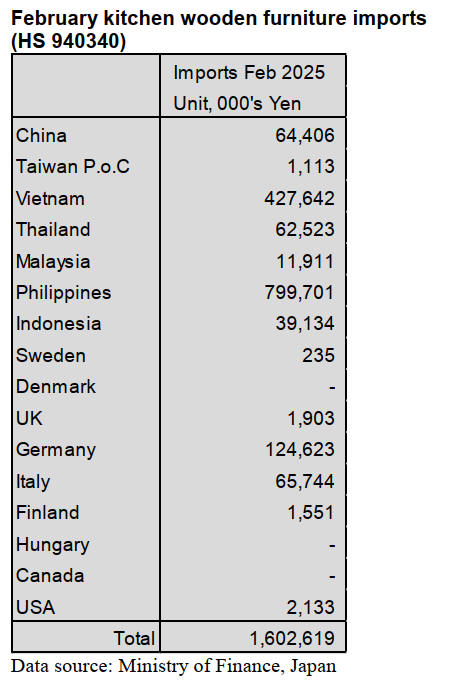
Shippers in the Philippines accounted for around 49% of
total imports of wooden kitchen furniture in February but
shipments from Vietnam dropped to just 28% of total
imports of HS940340. The other shippers of note in
February were Germany and Italy.
February wooden bedroom furniture imports
(HS940350)
The top two shippers of wooden bedroom furniture
(HS940350) to Japan in February were China (51%) and
Vietnam (36%). Malaysia and Thailand were the other
shippers of note in January with Malaysia, seeing a 5%
share of February imports, about the same level as in
January.
Compared to February 2024 there was an almost 20%
decline in the value of imports in February this year and a
massive 36% downward correction compared to the value
reported for January this year. Over the past four months
there was a steady upward trend in the value of wooden
bedroom furniture imports to Japan but this trend ended in
February but with shipments from China and Vietnam
being impacted by New Year celebrations, March may see
a reversal.
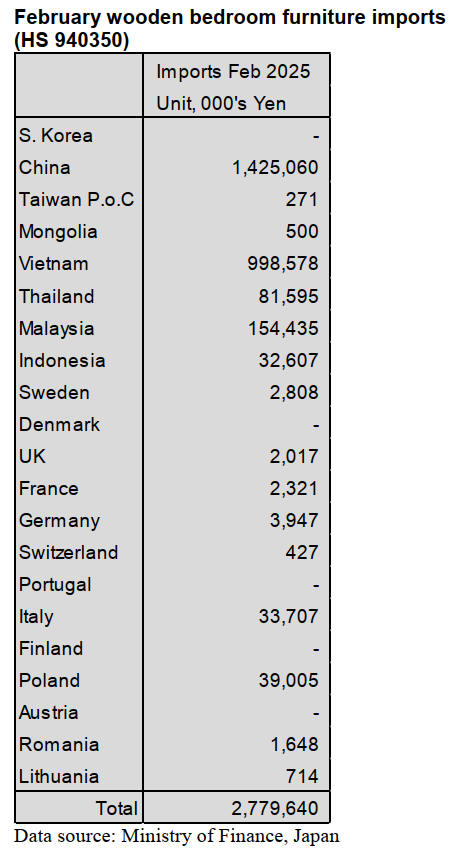
February wooden furniture parts imports (HS
940391)
Shippers in China, Indonesia, Vietnam and Malaysia, as in
previous months, accounted for most of Japan’s imports of
wooden furniture parts (HS940391) in February but the
total value of imports from these shippers was down
compared to a month earlier.
Of the total value of imports43% was delivered from
China, down from January; 19% from Indonesia,
unchanged from a month earlier; 11% from Vietnam and
10% from Malaysia, a significant increase. Compared to
the value of February 2024 imports there was decline of
9% in the value of February 2025 imports and a 29%
decline compared to January.
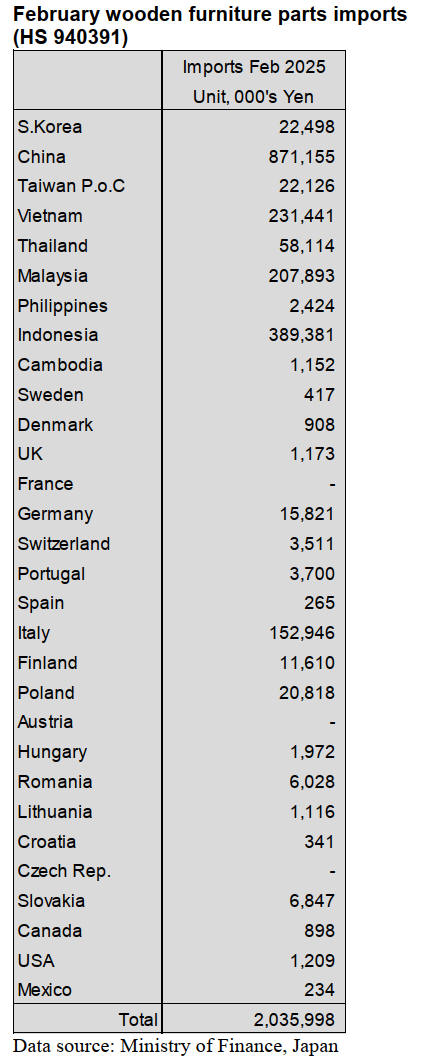
Trade news from the Japan Lumber Reports (JLR)
The Japan Lumber Reports (JLR), a subscription trade
journal published every two weeks in English, is
generously allowing the ITTO Tropical Timber Market
Report to reproduce news on the Japanese market
precisely as it appears in the JLR.
For the JLR report please see:
https://jfpj.jp/japan_lumber_reports/
No tariffs on wood products
The US President announced reciprocal tariffs on April
2nd, 2025. However, the reciprocal tariff is not on wood
products.
President Trump gave the order of tariffs for improve the
status of the United States and protect workers. He also
will impose a basic tariff of 10 % on all countries and will
add tax rates by countries or regions.
Japan’s tariff is 24. Vietnam’s tariff is 46 %. China’s tariff
is 34 %. India’s tariff is 26 %. South Korea’s tariff is 25
%. EU’s tariff is 20 %. However, wood products are not
subject to tariffs.
Additional tariff rates for Chin aare raised to 20 % from 10
% to avoid the flow of illegal drugs on March 3rd, 2025.
Then, China stopped importing American logs on March
4th, 2025. Timber trade tensions are brewing between the
U.S. and China.
Oji established corporate forest fund with New Forests
Oji Holdings Corporation in Tokyo, Japan established a
corporate forest investment fund, the “Future Forest
Innovation Fund” with New Forests Pty Limited in New
South Wales, Australia on 26th March, 2025.
The company aims to expand overseas forest plantation
areas to achieve the Oji Group’s environmental goals for
2030. Oji’s stake in Future Forest Innovation Fund is 99 %
and New Forests’ stake is 1 %.
The company aims to acquire approximately 70,000
hectares of forest plantation areas in South Asia, North
America, Central and South America and Africa thorough
this fund, with the goal of net absorption of 1.5 million
tons of CO2 in a year by 2030.
By leveraging New Forests’ sustainable forest
management expertise developed over the past 20 years,
advanced information analysis systems and sophisticated
use of geospatial data, the company aims to enhance the
productivity of the acquired plantations and conserve the
biodiversity of surrounding natural forests, thereby
improving the sustainable added value of the forests.
The fund will focus on investment activities and forestry
management activities, which Oji’s policy and intension of
forestry management. The fund’s forest assets would be
Oji’s business results.
Severe disaster
Japanese government announced that the Cabinet decided
to designate the forest fire in Ofunato city, Iwate
Prefecture as a severe disaster on 25th March, 2025. The
forest fire occurred on 19th February, 2025.
Related ordinances were also passed at a cabinet meeting
on the same day. The government will support Forest
Disaster Recovery Project to cut down and remove
damaged trees and afforest the areas.
The government published and implement about this at the
end of March, 2025.
Since the Act on Special Measures for Disaster Relief
against Severe Disasters came into effect, there have been
three forest fires that have been the subject of the law,
making this the fourth.
Domestic plywood
Plywood manufacturers keep raising the price. 12 mm 3 x
6 structural softwood plywood is 1,030 – 1,050 yen,
delivered per sheet in March, 2025. is 30 – 50 yen more
than February 2025 Movement of domestic plywood in
March, 2025 was worse than the movement in
February,2025.
Some plywood manufacturers could not raise the price by
1,100 yen, delivered per sheet, which they were going to
raise the price in March, 2025. Major plywood
manufacturers in Japan will raise the price by 50 yen in
April, 2025. The price would be 1,150 yen, delivered per
sheet.
The price has been raised for four months in a row. The
reasons are that the manufactures did not have enough
profits and the costs of logs, adhesives, and labors rose.
In Sarawak, Malaysia, there are not enough logs due to the
influence of a heavy rain in February 2025. Some plywood
plants in Sarawak which manufacture structural plywood
and painted plywood for concrete form had a decrease in
production in March. The delivery to Japan is delayed.
Movement of South Sea plywood in Japan is sluggish but
the inventory is very low due to less arrival volume.
Therefore, the price did not decrease even though the
trading companies had a financial closing period in March.
Rather, the Japanese importers tried to raise the plywood
price.
Structural plywood is around 1,550 yen, delivered per
sheet. 2.5 mm plywood is around 780 yen, delivered per
sheet and this is 30 yen more than last month. 4 mm
plywood is around 930 yen, delivered per sheet. 5.5 mm
Plywood is around 1,100 yen, delivered per sheet. In
South East Asia, 12 mm 3 x 6 painted plywood for
concrete form is US$590 - 600, C&F per cbm. Form
plywood is US$500 - 510, C&F per cbm.
Structural plywood is US$510 - 520, C&F per cbm. 2.4
mm 3 x 6 plywood is US$970, C&F per cbm. 3.7 mm 3 x
6 plywood is US$880, C&F per cbm. 5.2 mm 3 x 6
plywood is US$850, C&F per cbm.
Increased use of domestic lumber
There is an increase in using domestic lumber for 2 x 4
construction method. According to the survey of demand
and supply of domestic lumber in 2023, production of
structural lumber for 2 x 4 construction method at JAS
certificated plants is 89,435 cbms, 7.4 5 more than 2022.
A growth rate in 2023 became dull compared to the
growth rate in 2022. It was 9.2 % increased in 2022.
The survey was held to 63 housing companies, 26
component companies and 23 lumber companies. The
production of domestic lumber increased for 3 years
continuously. The estimated production of 2024 would be
100,200 cbms. The housing companies, which had
answered to the survey, would have more new starts in
2024 than 2023.
80 % of production is cedar lumber but cypress lumber in
2023 increased by 6.1 %, 4.3 points more than the
previous year. 4 x 4 or 4 x 6 cypress lumber is 6.7 %, 4.9
points more than last year. It is presumed that cypress
lumber as sills has increased. Production of Sakhalin fir
lumber dropped in 2023 but Sakhalin fir lumber would
increase in 2024. Production of 2 x 6 lumber is 23.4 %, 0.9
point more than last year. It would also rise in 2024. 2 x 6
lumber is used at outer walls as high thermal insulation
products. A ratio of using finger joints is 30 % and it
would be important to use more finger joints for
improving the yield.
The results of estimated CO2 emissions from the use of
domestic timber were also compiled. It was calculated and
compared emissions when using imported and domestic
timber for a housing model with the same design.
As a result, the use of domestic timber is approximately
0.64 tons less than that of North American timber and 1.60
tons less than European lumber. However, domestic
lumber’s CO2 emissions are a lot during the
manufacturing process.
The reason is that renewable energy, such as biomass
power generation, are consumed at lumber plants in
Europe and North America. It would be important to
reduce CO2 emissions at the manufacturing process and to
contribute decarburization.
|